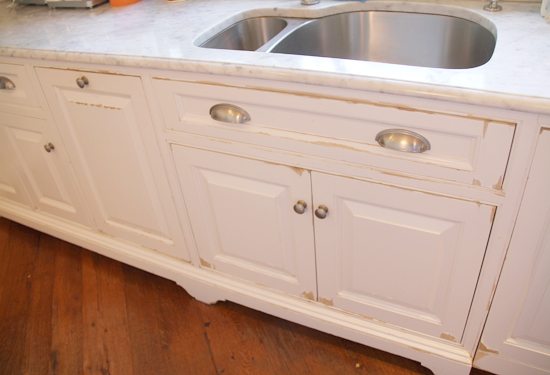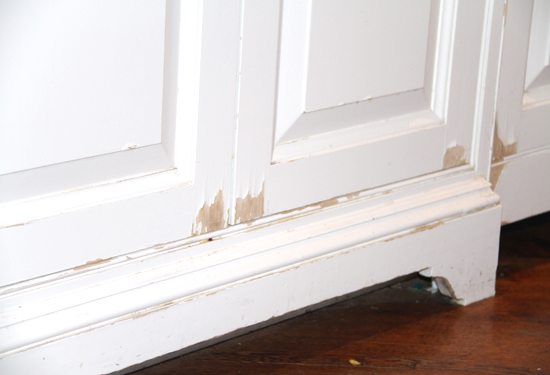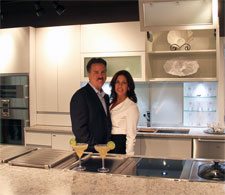Factory vs Job Site Finishes
If you ever want the opportunity to see first-hand the process of creating a superior quality factory finish and why the finishing process is vital to ensuring the durability of your cabinetry, we would love the opportunity to show you. We think it is important for you to know what to expect in order to make an educated decision and understand the difference between a lifelong factory finish vs a shop that builds your cabinets and paints them on site at your home. Here we outline the process and the 7 essential questions you should be asking your contractor/designer when making crucial cabinet-purchasing decisions.
The photos you see below are from a homeowner whose kitchen was shop built and field painted in their home. Their kitchen is only 5 years old. They allowed us to take these photos when they consulted us regarding what needed to be done to fix their kitchen. It happens to be a spectacularly designed kitchen in a fabulous Long Island home. However, the paint is chipping… not an uncommon situation with on-site painted finishes… but nonetheless, the homeowner didn’t realize that their kitchen would require ongoing maintenance. They only have two real options: (1) They can sand their kitchen down to raw wood and repaint it; OR, (2) They can replace it with custom cabinetry that is factory finished and warrantied for life.
When planning your kitchen, the durability of the finish is an important consideration, especially if you don’t want the inconvenience of having to maintain it every couple of years and having to endure the sanding, dust, paint smell, and general household intrusion. If you are purchasing custom cabinetry, here are 7 questions you should be asking your contractor, designer, or cabinetmaker.
1) Do you make all of the parts yourself “in house” or do you buy loose components like doors and drawers from an outside third party vendor? The manufacturers we work with (Bentwood, Wood-Mode, Allmilmo, etc.) make all their own doors and components. That way, they have complete control over the quality of the wood used and its moisture content. We watched the mechanics at Bentwood cut the sapwood out of the raw lumber to allow for only the highest grade of lumber to be used. If your cabinetmaker outsources components, they have little control of the quality of those pieces.
2) Do you check for moisture content in all the wood prior to actually making product from it? Our factories kiln-dry and check every piece of wood to achieve optimum moisture content, which ensures that you don’t have excess moisture in the wood. This intensive lumber-drying process prevents adhesion problems with your finishes, and it also minimizes the expansion/contraction results in the finished product. To achieve superior adhesion, the wood must be dried to a range between 4.2 and 4.7% moisture content.
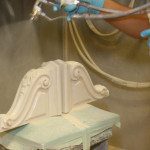 3) Are you finishing the cabinetry in your shop or on the job site and what are you doing to ensure that your painting environment is dust free so dirt or hairs from paintbrushes are not seen in the finished product? In our factories, there is much better control of dust because there is a specialized area that filters all the air going in and all the air going out. This finishing area maintains negative pressure at all times, which means there is constant air being pushed out of the environment so that other dust and particles can’t find their way in through doorways or openings. Most smaller shops cannot afford this type of dust control, and it is not possible with a job site application. No matter how hard your contractor tries to clean the job site area during prep, they cannot keep the air clean during the finishing process without filters. Spraying the product on site actually stirs up the air and dust during the application of the finish. You can feel the difference of a factory finish produced in a dust free environment. Rub the product with the softer back side of your fingers and feel the difference.
3) Are you finishing the cabinetry in your shop or on the job site and what are you doing to ensure that your painting environment is dust free so dirt or hairs from paintbrushes are not seen in the finished product? In our factories, there is much better control of dust because there is a specialized area that filters all the air going in and all the air going out. This finishing area maintains negative pressure at all times, which means there is constant air being pushed out of the environment so that other dust and particles can’t find their way in through doorways or openings. Most smaller shops cannot afford this type of dust control, and it is not possible with a job site application. No matter how hard your contractor tries to clean the job site area during prep, they cannot keep the air clean during the finishing process without filters. Spraying the product on site actually stirs up the air and dust during the application of the finish. You can feel the difference of a factory finish produced in a dust free environment. Rub the product with the softer back side of your fingers and feel the difference.
 4) What are you using as the topcoat to provide a durable, strong, long-lasting finish? Are you using a catalyst in the varnish? Most local custom shops/on-site finishers do not have the capacity to use a catalyzed varnish as the finish topcoat. Some reasons preventing them from using a catalyst are: (1) it requires much more expensive equipment that must be shot through stainless steel guns; (2) the equipment is much more difficult to maintain; and (3) they are forced to work in very short cycles due to the limited curing time (where the paint hardens quickly) causing a labor intensive cleanup. This process would make their job much more expensive to operate. Since their options are limited, most local shop/job-site finished projects use a polyurethane or a lacquer topcoat, which is no where near the same hardness/durability level as the catalyzed varnish process. You want a catalyst within the varnish because that’s what makes the finish hard enough so it is durable and doesn’t come apart. A catalyzed varnish finish is impervious to most household chemicals, including acetone, the major additive to nail polish remover. Without a catalyst, household cleaners will slowly erode the finish. Our factories use catalyzed finishes so durable that a permanent Sharpie pen mark can wipe clean with acetone and not affect the finish (we tested this ourselves). Bentwood tells clients to try this test: Ask your contractor to provide you with a sample of their work (preferably a cabinet door) and drop a small amount of fingernail polish remover on the back of the door so as not to ruin the front. If the contractor is using lacquer or polyurethane, the finish will lift away from the door.
4) What are you using as the topcoat to provide a durable, strong, long-lasting finish? Are you using a catalyst in the varnish? Most local custom shops/on-site finishers do not have the capacity to use a catalyzed varnish as the finish topcoat. Some reasons preventing them from using a catalyst are: (1) it requires much more expensive equipment that must be shot through stainless steel guns; (2) the equipment is much more difficult to maintain; and (3) they are forced to work in very short cycles due to the limited curing time (where the paint hardens quickly) causing a labor intensive cleanup. This process would make their job much more expensive to operate. Since their options are limited, most local shop/job-site finished projects use a polyurethane or a lacquer topcoat, which is no where near the same hardness/durability level as the catalyzed varnish process. You want a catalyst within the varnish because that’s what makes the finish hard enough so it is durable and doesn’t come apart. A catalyzed varnish finish is impervious to most household chemicals, including acetone, the major additive to nail polish remover. Without a catalyst, household cleaners will slowly erode the finish. Our factories use catalyzed finishes so durable that a permanent Sharpie pen mark can wipe clean with acetone and not affect the finish (we tested this ourselves). Bentwood tells clients to try this test: Ask your contractor to provide you with a sample of their work (preferably a cabinet door) and drop a small amount of fingernail polish remover on the back of the door so as not to ruin the front. If the contractor is using lacquer or polyurethane, the finish will lift away from the door.
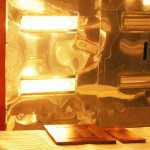 5) How do you dry your finishes between layers or steps in your finishing process? Drying between layers is a critical step that the factory uses. They use massive ovens with high-powered lights to “oven bake” the finish and accelerate the drying process. Some finishes require up to 28 steps. Drying before applying the next layer assures maximum adhesion to guarantee that the finish sticks.
5) How do you dry your finishes between layers or steps in your finishing process? Drying between layers is a critical step that the factory uses. They use massive ovens with high-powered lights to “oven bake” the finish and accelerate the drying process. Some finishes require up to 28 steps. Drying before applying the next layer assures maximum adhesion to guarantee that the finish sticks.
6) What kind of warranty on your work do you offer? The factory confidently offers a lifetime warranty on the product because they know the finish will last.
7) Do you have references from people whose projects are 5+ years old? Ask to see a couple of projects with a similar finish that are 5+ years old, and see for yourself how the finishes have held up.
Although we highly advocate using a factory finish for your projects, we are by no means saying a custom shop is a poor choice. Kitchen Designs by Ken Kelly has its own local custom shop that we use to make specialty pieces such as dining hutches and wall units that don’t get the same wear and tear as a kitchen. Our experience with non factory finishes is that they chip more easily and can require ongoing maintenance. So to avoid the hassle and additional expense, we prefer to use catalyzed varnish finishes especially in high use areas.
(Update: This client eventually asked us to replace their entire kitchen.) Benjamin Franklin’s quote: “The bitterness of poor quality remains png after the sweetness of low price is forgotten.”
Related Reading:
Know What You’re Looking at in a Hand Painted Kitchen Cabinet Finish

